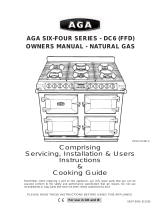Essential Information
Before thorough cleaning isolate the electricity supply.
Remember to switch on the electricity supply before use.
Do not use a steam cleaner to clean this cooker.
Never use paint solvents, washing soda, caustic cleaners,
biological powders, bleach, chlorine based bleach
cleaners, coarse abrasives or salt. Don’t mix different
cleaning products - they may react together with
hazardous results.
Recommended cleaning materials are shown in the table
at the end of this section.
If you want to move your cooker for cleaning, see the
section called ‘Positioning the cooker’.
All parts of the cooker can be cleaned with hot soapy
water - but take care that no surplus water seeps into
the appliance.
For cleaning materials see the ‘Cleaning Table’ at the end
of this section.
The Slow Cooking Oven and the Grill
The slow cooking oven and the grill have side panels that
are coated with a special enamel that partly cleans itself.
Do not use any cleaning materials which may clog the
pores of the special coating e.g. Pastes and powders,
soap filled pads, wire wool, spray cleaners, brush-on oven
cleaners, caustic solutions, metal scrapers/knives, and
prevent the continuous cleaning action.
The shelf is designed to lock in place, but is removable for
cleaning. To remove lift up at the front then pull forward.
The grill pan and grid should be washed in hot soapy
water.
After grilling meat or any food that soils, leave the grill pan
to soak for a few minutes in the sink immediately after use.
Stubborn particles may be removed from the grid by using
a nylon brush.
Control Panel and Oven Doors
For best results liquid detergents should be used.
The control panel and control knobs should only be
cleaned with a soft cloth wrung out in clean hot soapy
water - but take care that no surplus water seeps into the
appliance. Wipe with a clean dampened cloth then polish
with a dry cloth. The oven doors should only be cleaned
with a soft cloth wrung out in clean hot soapy water.
The Fan Ovens
The ovens have panels which have been coated with a
special enamel that partly cleans itself. This does not stop
all marks on the lining, but helps to reduce the amount of
manual cleaning needed.
The panels work best if a pattern of low and high
temperature cooking is followed. Occasionally wipe with a
lint free cloth and hot soapy water. When the panels are
dry, heat the ovens to 200°C for about one hour. This will
ensure the panels are working effectively.
Do not use steel wool (Brillo) or any other materials that
will scratch the surface. Do not use oven cleaning pads.
Ceramic Glass Hob
z Try not to let liquids boil over.
z Wipe up spills as they occur.
z Always use a clean cloth (not one that has been used
for greasy washing up).
z Burnt on substances such as sugar, acidic food,
kitchen foil or plastic should be removed
IMMEDIA
TELY whilst the hob is still hot with a
proprietary razor blade scraper. The hob should then
be cleaned with a proprietary cleaner such as Hob
Brite or Easy Do.
DO NOT USE HOB BRITE ON ENAMELLED
SURFACES.
Cleaning the cooker
20























